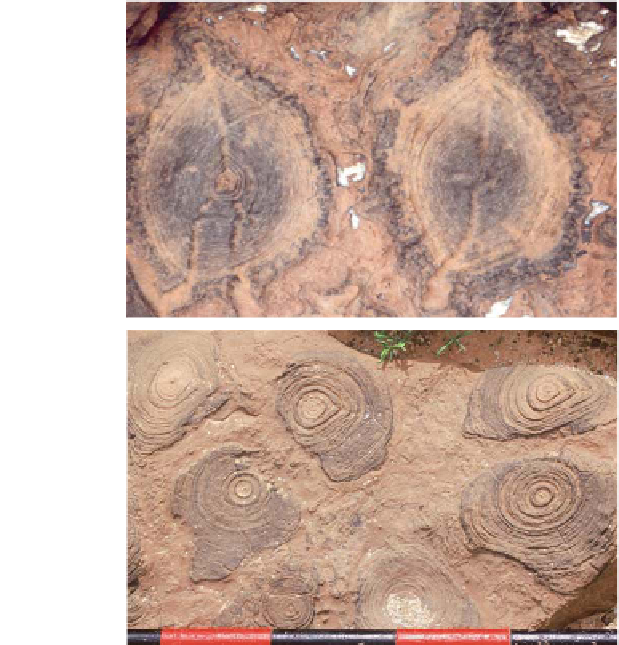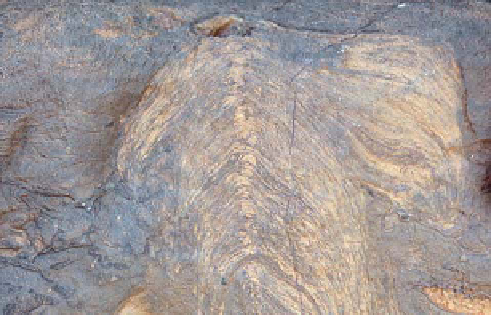Geology Reference
In-Depth Information
(a)
(b)
5 cm
10 cm
(d)
(c)
2.5 cm
Fig. 6.
Morphological features of conical stromatolites. (a) Secondary growth of
Conophyton
without disruption of
initial conical laminae. (b) Elliptical cross section of
Conophyton
showing irregular thickening of outermost laminae.
(c) Delamination of partially lithifi ed
Conophyton
laminae. (d) Eroded margins of
Conophyton
indicate exposure to wave
action after lithifi cation, but prior to deposition of interstromatolitic material. Jacob staff divisions are 10 cm.
Interstromatolitic regions of
Jacutophyton
consist exclusively of platy breccia and several
generations of precipitated carbonate cement
(Fig. 9; see descriptions below). The general
absence of breccia between branching elements,
and the presence of rare laminae that envelop
numerous branches (Fig. 5b), however, suggest
that interstromatolitic debris was deposited pri-
marily after the growth of branches.
margins of low synoptic relief (< 2 cm) and
variably divergent, asymmetric branching.
Branching columns of moderate relief include the
form-taxa
Tungussia confusa
(Fig. 8b)
, Baicalia
safi a and Baicalia mauritanica
(Fig. 8c and d).
These stromatolites have columns that widen
upward and branch at irregular intervals. Synoptic
relief varies from nearly fl at (horizontal lamina) to
~8 cm. In the Atar Formation, stromatolites attrib-
utable to
Tungussia
occur only in the inter-reef
shaly intervals, whereas
Tilemsina
and
Baicalia
both occur as reef elements.
Intercolumnar regions of branching stromato-
lites vary widely and can contain platy breccia,
detrital microspar and several generations of
precipitated carbonate cement (see descriptions
below).
Tilemsina
, however, is associated exclu-
sively with fi ne-grained platy breccia (Fig. 8a),
and
Tungussia
is associated exclusively with
detrital microsparitic carbonate (Fig. 8b). By
contrast, intercolumnar regions of
Baicalia
are
quite variable, often consisting of a generation
Branching columnar stromatolites
Low- to moderate-relief columnar stromatolites
comprise several morphotypes of variably branch-
ing columnar stromatolites with synoptic relief of
no more than a few centimetres (Fig. 8). Branches
are typically moderately to highly divergent, pro-
ducing stromatolites that widen upward. These
forms have low to moderate inheritance and
produce biostromes composed of numerous col-
umns.
Tilemsina divergens
(Fig. 8a) and related
forms are characterized by irregular unwalled





